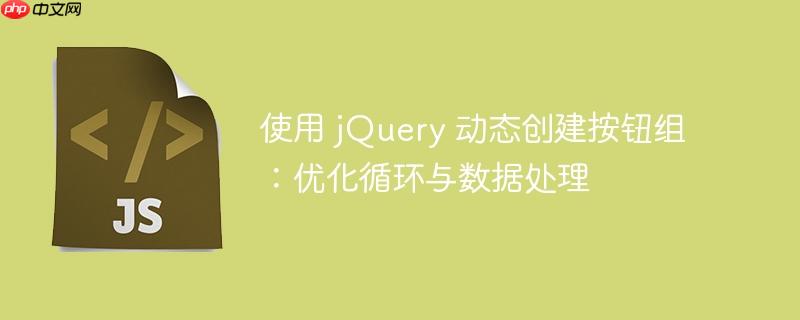
正如前文所述,本文将探讨如何使用 jQuery 动态地从数据源生成一系列按钮或链接,并将其组织成特定的结构。关键在于优化循环逻辑,确保所有数据都能正确渲染,避免因 return 语句导致循环提前结束的问题。我们将通过示例代码演示如何使用 slice 方法分割数据,并使用 map 方法高效地构建 HTML 结构。
动态生成 HTML 元素是 Web 开发中常见的需求,尤其是在处理来自 API 或其他数据源的数据时。以下是一种更有效的方法,可以避免在 append() 中使用 for 循环时遇到的问题。
核心思路:
代码示例:
假设我们有以下数据结构:
let testButtonEntries = [
{ button_title: 'Employee Button Title', button_alt_text: 'Employee Alt Text', button_image: 'emp_button_title', link: 'insertsomelinkhere' },
{ button_title: 'Employee Button Title', button_alt_text: 'Employee Alt Text', button_image: 'emp_button_title', link: 'somelinktosomewhere.com/' },
{ button_title: 'Employee Button Title', button_alt_text: 'Employee Alt Text', button_image: 'emp_button_title', link: 'somelinktosomewhere.com/' },
// ... 更多数据
{ button_title: 'Employee Button Title Last', button_alt_text: 'Employee Alt Text Last', button_image: 'emp_button_title_last', link: 'insertsomelinkhere.org' }
];以下是使用 slice 和 map 方法动态生成按钮组的 jQuery 代码:
$(document).ready(function () {
const rows = [];
const size = 15; // 每个数组块包含的元素数量
// 将原始数据分割成多个数组块
while (testButtonEntries.length > 0) {
rows.push(testButtonEntries.splice(0, size));
}
// 使用 map 方法构建 HTML 字符串
const data = rows.map((row) => {
const elements = row.map((ele) => {
const { button_title, link, button_image, button_alt_text } = ele;
return `<div class=""><a href="${link}" title="${button_title}" target="_blank"><img src="images/${button_image}.png" class="img-responsive" alt="${button_alt_text}"/></a></div>`;
}).join(''); // 将数组元素连接成一个字符串
return `<div class="carousel-item"><div class="d-flex flex-wrap">${elements}</div></div>`;
}).join(''); // 将数组元素连接成一个字符串
// 将生成的 HTML 字符串插入到目标元素中
$("#employee-button-container").html(data);
});代码解释:
注意事项:
总结:
通过使用 slice 方法分割数据,并使用 map 方法高效地构建 HTML 结构,可以更有效地动态生成按钮组,避免在 append() 中使用 for 循环时遇到的问题。这种方法不仅代码更简洁,而且性能也更好。 记住,代码的可读性和可维护性同样重要,所以请始终保持代码的清晰和简洁。
以上就是使用 jQuery 动态创建按钮组:优化循环与数据处理的详细内容,更多请关注php中文网其它相关文章!

每个人都需要一台速度更快、更稳定的 PC。随着时间的推移,垃圾文件、旧注册表数据和不必要的后台进程会占用资源并降低性能。幸运的是,许多工具可以让 Windows 保持平稳运行。

Copyright 2014-2025 https://www.php.cn/ All Rights Reserved | php.cn | 湘ICP备2023035733号